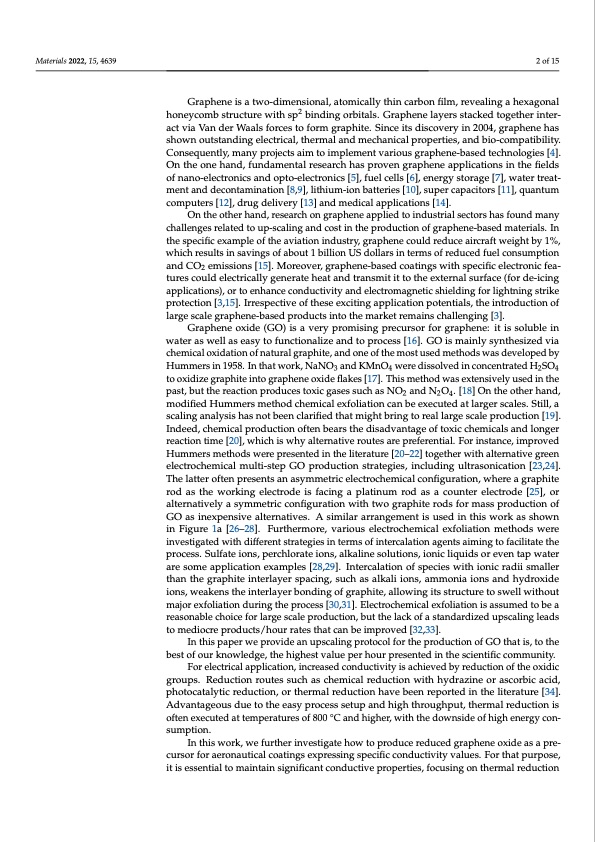
PDF Publication Title:
Text from PDF Page: 002
Materials 2022, 15, 4639 2 of 15 Graphene is a two-dimensional, atomically thin carbon film, revealing a hexagonal honeycomb structure with sp2 binding orbitals. Graphene layers stacked together inter- act via Van der Waals forces to form graphite. Since its discovery in 2004, graphene has shown outstanding electrical, thermal and mechanical properties, and bio-compatibility. Consequently, many projects aim to implement various graphene-based technologies [4]. On the one hand, fundamental research has proven graphene applications in the fields of nano-electronics and opto-electronics [5], fuel cells [6], energy storage [7], water treat- ment and decontamination [8,9], lithium-ion batteries [10], super capacitors [11], quantum computers [12], drug delivery [13] and medical applications [14]. On the other hand, research on graphene applied to industrial sectors has found many challenges related to up-scaling and cost in the production of graphene-based materials. In the specific example of the aviation industry, graphene could reduce aircraft weight by 1%, which results in savings of about 1 billion US dollars in terms of reduced fuel consumption and CO2 emissions [15]. Moreover, graphene-based coatings with specific electronic fea- tures could electrically generate heat and transmit it to the external surface (for de-icing applications), or to enhance conductivity and electromagnetic shielding for lightning strike protection [3,15]. Irrespective of these exciting application potentials, the introduction of large scale graphene-based products into the market remains challenging [3]. Graphene oxide (GO) is a very promising precursor for graphene: it is soluble in water as well as easy to functionalize and to process [16]. GO is mainly synthesized via chemical oxidation of natural graphite, and one of the most used methods was developed by Hummers in 1958. In that work, NaNO3 and KMnO4 were dissolved in concentrated H2SO4 to oxidize graphite into graphene oxide flakes [17]. This method was extensively used in the past, but the reaction produces toxic gases such as NO2 and N2O4. [18] On the other hand, modified Hummers method chemical exfoliation can be executed at larger scales. Still, a scaling analysis has not been clarified that might bring to real large scale production [19]. Indeed, chemical production often bears the disadvantage of toxic chemicals and longer reaction time [20], which is why alternative routes are preferential. For instance, improved Hummers methods were presented in the literature [20–22] together with alternative green electrochemical multi-step GO production strategies, including ultrasonication [23,24]. The latter often presents an asymmetric electrochemical configuration, where a graphite rod as the working electrode is facing a platinum rod as a counter electrode [25], or alternatively a symmetric configuration with two graphite rods for mass production of GO as inexpensive alternatives. A similar arrangement is used in this work as shown in Figure 1a [26–28]. Furthermore, various electrochemical exfoliation methods were investigated with different strategies in terms of intercalation agents aiming to facilitate the process. Sulfate ions, perchlorate ions, alkaline solutions, ionic liquids or even tap water are some application examples [28,29]. Intercalation of species with ionic radii smaller than the graphite interlayer spacing, such as alkali ions, ammonia ions and hydroxide ions, weakens the interlayer bonding of graphite, allowing its structure to swell without major exfoliation during the process [30,31]. Electrochemical exfoliation is assumed to be a reasonable choice for large scale production, but the lack of a standardized upscaling leads to mediocre products/hour rates that can be improved [32,33]. In this paper we provide an upscaling protocol for the production of GO that is, to the best of our knowledge, the highest value per hour presented in the scientific community. For electrical application, increased conductivity is achieved by reduction of the oxidic groups. Reduction routes such as chemical reduction with hydrazine or ascorbic acid, photocatalytic reduction, or thermal reduction have been reported in the literature [34]. Advantageous due to the easy process setup and high throughput, thermal reduction is often executed at temperatures of 800 °C and higher, with the downside of high energy con- sumption. In this work, we further investigate how to produce reduced graphene oxide as a pre- cursor for aeronautical coatings expressing specific conductivity values. For that purpose, it is essential to maintain significant conductive properties, focusing on thermal reductionPDF Image | Electrochemical Production Thermal Reduction Graphene Oxide

PDF Search Title:
Electrochemical Production Thermal Reduction Graphene OxideOriginal File Name Searched:
materials-15-04639.pdfDIY PDF Search: Google It | Yahoo | Bing
Salgenx Redox Flow Battery Technology: Power up your energy storage game with Salgenx Salt Water Battery. With its advanced technology, the flow battery provides reliable, scalable, and sustainable energy storage for utility-scale projects. Upgrade to a Salgenx flow battery today and take control of your energy future.
| CONTACT TEL: 608-238-6001 Email: greg@infinityturbine.com | RSS | AMP |